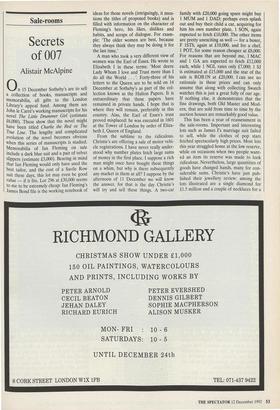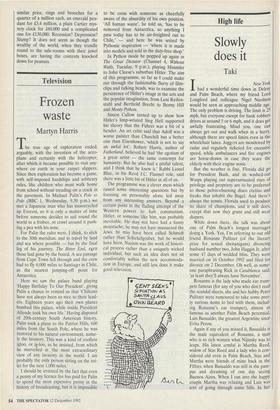Sale-rooms
Secrets of 007
Alistair McAlpine
On 15 December Sotheby's are to sell a collection of books, manuscripts and memorabilia, all gifts to the London Library's appeal fund. Among them are John le Carres working manuscripts for his novel The Little Drummer Girl (estimate £6,000). These show that the novel might have been titled Charlie the Red or The True Line. The lengthy and complicated evolution of the novel becomes obvious when this series of manuscripts is studied. Memorabilia of Ian Fleming on sale include a dark blue suit and a pair of velvet slippers (estimate £3,000). Bearing in mind that Ian Fleming would only have used the best tailor, and the cost of a Savile Row suit these days, this lot may even be good value — if it fits. Lot 296 at £30,000 seems to me to be extremely cheap: Ian Fleming's James Bond file is the working notebook of
ideas for those novels (intriguingly, it men- tions the titles of proposed books) and is filled with information on the character of Fleming's hero, his likes, dislikes and habits, and scraps of dialogue. For exam- ple: 'The older women are best, because they always think they may be doing it for the last time.'
A man who took a very different view of women was the Earl of Essex. He wrote to Elizabeth I in these terms: 'Most deere Lady Whom I love and Trust more than I do all the World .. . '. Forty-three of his letters to the Queen are to be sold on 14 December at Sotheby's as part of the col- lection known as the Hulton Papers. It is extraordinary that these papers have remained in private hands. I hope that is where they will remain, preferably in this country. Alas, the Earl of Essex's trust proved misplaced: he was executed in 1601 at the Tower of London by order of Eliza- beth I, Queen of England.
From the sublime to the ridiculous. Christie's are offering a sale of motor vehi- cle registrations. I have never really under- stood why number plates fetch large sums of money in the first place. I suppose a rich man might once have bought these things on a whim, but why is there subsequently any market in them at all? I suppose by the afternoon of 11 December we will know the answer, for that is the day Christie's will try and sell these things. A two-car family with £20,000 going spare might buy 1 MUM and 1 DAD; perhaps even splash out and buy their child a car, acquiring for him his own number plate, 1 SON, again expected to fetch £10,000. The other items are pretty unexciting as well — for a boxer, F 1STS, again at £10,000, and for a chef, 1 POT, for some reason cheaper at £8,000. For reasons that are beyond me, 1 MAC and 1 GA are expected to fetch £12,000 each, while 1 NGL rates only £7,000; 1 SJ is estimated at £15,000 and the star of the sale is ROB 1N at £20,000. I can see no rationale in these prices and can only assume that along with collecting Swatch watches this is just a great folly of our age. If nothing else, it demonstrates that the fine drawings, both Old Master and Mod- ern, that are sold from time to time by the auction houses are remarkably good value.
This has been a year of reassessment in the sale-rooms. Important and interesting lots such as James I's marriage suit failed to sell, while the clothes of pop stars fetched spectacularly high prices. Most lots this year struggled home at the low reserve, while on occasions when two people want- ed an item its reserve was made to look ridiculous. Nevertheless, large quantities of goods have changed hands, many for con- siderable sums. Christie's have just pub- lished their jewellery review: among the lots illustrated are a single diamond for £1.5 million and a couple of necklaces for a similar price, rings and brooches for a quarter of a million each, an emerald pen- dant for £3.4 million, a plain Cartier mys- tery clock for £60,000 and a complicated one for £130,000. Recession? Depression? Slump? It does not seem as though the wealthy of the world, when they trundle round to the sale-rooms with their jewel boxes, are having the contents knocked down for peanuts.



































































 Previous page
Previous page